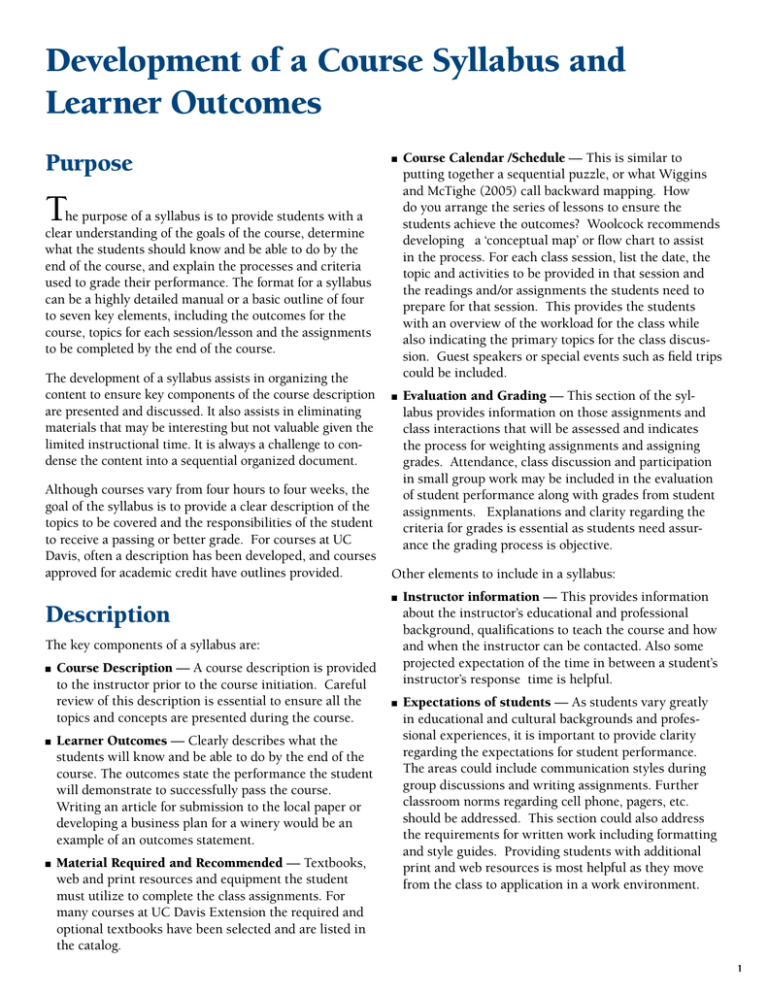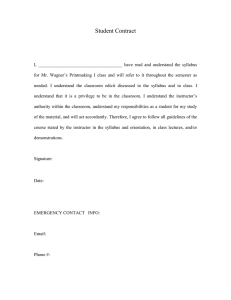Development of a Course Syllabus and Learner Outcomes
advertisement

Development of a Course Syllabus and Learner Outcomes Purpose ■■ T he purpose of a syllabus is to provide students with a clear understanding of the goals of the course, determine what the students should know and be able to do by the end of the course, and explain the processes and criteria used to grade their performance. The format for a syllabus can be a highly detailed manual or a basic outline of four to seven key elements, including the outcomes for the course, topics for each session/lesson and the assignments to be completed by the end of the course. The development of a syllabus assists in organizing the content to ensure key components of the course description are presented and discussed. It also assists in eliminating materials that may be interesting but not valuable given the limited instructional time. It is always a challenge to condense the content into a sequential organized document. Although courses vary from four hours to four weeks, the goal of the syllabus is to provide a clear description of the topics to be covered and the responsibilities of the student to receive a passing or better grade. For courses at UC Davis, often a description has been developed, and courses approved for academic credit have outlines provided. Description ■■ ■■ ■■ Course Description — A course description is provided to the instructor prior to the course initiation. Careful review of this description is essential to ensure all the topics and concepts are presented during the course. Learner Outcomes — Clearly describes what the students will know and be able to do by the end of the course. The outcomes state the performance the student will demonstrate to successfully pass the course. Writing an article for submission to the local paper or developing a business plan for a winery would be an example of an outcomes statement. Material Required and Recommended — Textbooks, web and print resources and equipment the student must utilize to complete the class assignments. For many courses at UC Davis Extension the required and optional textbooks have been selected and are listed in the catalog. Evaluation and Grading — This section of the syllabus provides information on those assignments and class interactions that will be assessed and indicates the process for weighting assignments and assigning grades. Attendance, class discussion and participation in small group work may be included in the evaluation of student performance along with grades from student assignments. Explanations and clarity regarding the criteria for grades is essential as students need assurance the grading process is objective. Other elements to include in a syllabus: ■■ The key components of a syllabus are: ■■ Course Calendar /Schedule — This is similar to putting together a sequential puzzle, or what Wiggins and McTighe (2005) call backward mapping. How do you arrange the series of lessons to ensure the students achieve the outcomes? Woolcock recommends developing a ‘conceptual map’ or flow chart to assist in the process. For each class session, list the date, the topic and activities to be provided in that session and the readings and/or assignments the students need to prepare for that session. This provides the students with an overview of the workload for the class while also indicating the primary topics for the class discussion. Guest speakers or special events such as field trips could be included. ■■ Instructor information — This provides information about the instructor’s educational and professional background, qualifications to teach the course and how and when the instructor can be contacted. Also some projected expectation of the time in between a student’s instructor’s response time is helpful. Expectations of students — As students vary greatly in educational and cultural backgrounds and professional experiences, it is important to provide clarity regarding the expectations for student performance. The areas could include communication styles during group discussions and writing assignments. Further classroom norms regarding cell phone, pagers, etc. should be addressed. This section could also address the requirements for written work including formatting and style guides. Providing students with additional print and web resources is most helpful as they move from the class to application in a work environment. 1 References Brown University, Sheridan Center for Teaching and Learning. Constructing a syllabus, http://www.brown.edu/ Administration/Sheridan_Center/publications/ (prepared by Michael J. V. Woolcock). ■ This online practical guide describes the syllabus as a four-way agreement between the instructor, students, department and university. It discusses developing objectives to address students’ learning styles. Grunert O’Brien, Judith, Barbara J. Mills, and Margaret W. Cohen. The Course Syllabus: A Learning-Centered Approach (2nd Ed.). San Francisco, CA, 2008. ■ This book provides over 63 pages of examples detailing every component of writing a course syllabus. Designed for college faculty, it stresses a learner-centered approach to engage students in the learning process. Wiggins, Grant, and Jay McTighe. Understanding by Design (2nd Ed.). Alexandria, VA: Association for Supervision and Curriculum Development, 2005. ■ 2 This book starts with the end, the outcomes, and then requires the instructors to backward plan to ensure all the lessons and assessment result in achievement of the outcomes.

